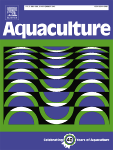Growth and food source of the sea cucumber Apostichopus japonicus cultured below fish cages — Potential for integrated multi-trophic aquaculture
Hisashi Yokoyama

In order to examine the efficiency of co-culturing fish with the Japanese common sea cucumberApostichopus japonicus, field cultivation experiments were conducted in Gokasho Bay, central Japan. I cultured A. japonicus juveniles below a fish cage and at a control station for 238 days, monitored the wet weight, and analyzed its stable carbon and nitrogen isotopes (δ13C, δ15N) together with potential food sources, and found that (1) juveniles cultured below fish cages exhibited high survivorship (96%) and significantly higher specific growth rate (1.9%) than those at the control site (1.2%), and (2) the juveniles had significantly reduced δ13C values (mean ± SD = − 19.1 ± 0.3‰ vs. −17.5 ± 0.4‰ at the control station), suggesting the incorporation of C3 plant material in fish feed through fish feces and settling organic matter. All sea cucumbers which were further cultured for additional 307 days below fish cages grew to the marketable size (range and mean wet weight = 142–181 g, 160 g, n = 9). In order to evaluate the effect of density on growth, 6 culture vessels, in which 1, 5, 10, 15, 20 and 25 juveniles of A. japonicus were stocked, were maintained below the fish cage over 118 days. The results showed that the final mean weight of A. japonicus decreased from 6.68 g to 0.94 g as the density increased with a large variation of weight at the end of the experiment (coefficient of variation = 52.1–62.2%), suggesting that there was competition between individuals for a limited food supply and there were intraspecific effects on the growth. This study shows the possibility of integrated multi-trophic aquaculture in which A. japonicus is cultured in the water column below fish cages, because the survival and growth of the sea cucumbers were enhanced due to the ability to avoid predator interactions and adverse environmental conditions as well as nutritional feed supply from the fish cage.
"Tài liệu điện tử trên trang tepbac được chia sẻ để sử dụng cho mục đích học tập và nghiên cứu cá nhân. Nghiêm cấm mọi hình thức sao chép, in ấn phục vụ các mục đích khác nếu không được sự chấp nhận của tác giả và nhà xuất bản."







